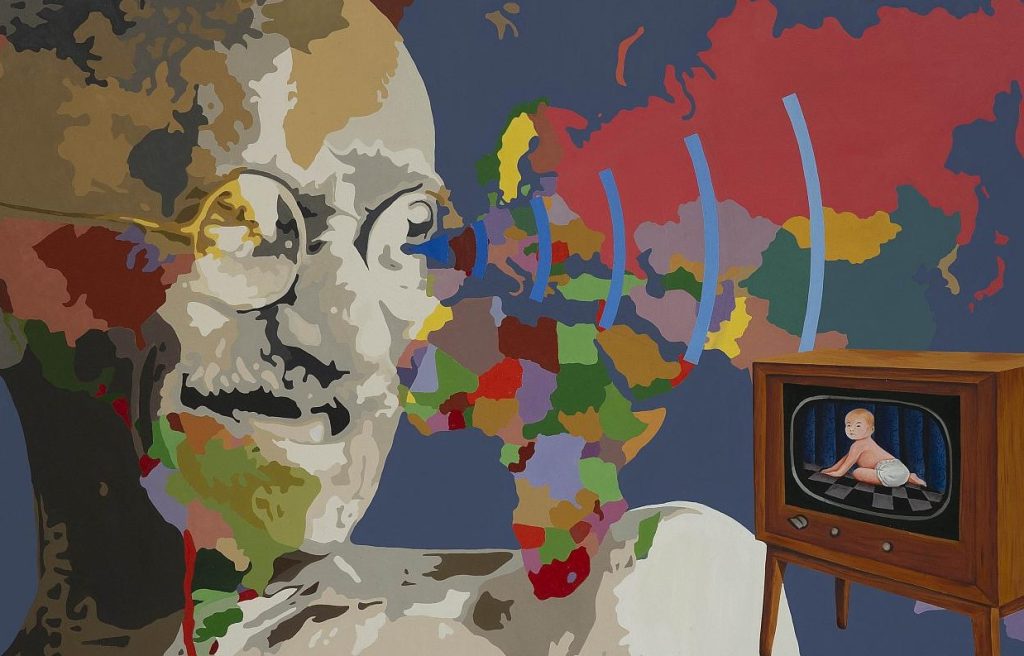A lean, old, bald man clothed in a white dhoti, wearing round glasses and holding a cane stick. We have all come across this iconic representation at some point. As simple and mundane as it may sound, this image of Mohandas Karamchand Gandhi, popularly known as Mahatma Gandhi, has stayed in our visual memories for decades. Fondly remembered by Indians as Bapu, he was an anti-colonial nationalist who played an important role in the nation’s freedom struggle in the early twentieth century. Gandhi has since been a constant subject of artistic representation and exploration throughout the country, with artists re-looking at, commemorating, and critiquing him and his ideology in their works.
An exhibition on similar thematics was on view during the early days of October 2023 in the Kalakriti Art Gallery of Hyderabad. This prompted an inquiry to examine the relevance of representing Gandhi in the contemporary scenario. Showcasing a solo show of the artworks of a Baroda-based artist, Adarsh Baji, the exhibition titled, ‘Give Peace Another Chance’ was a tribute to the Mahatma and his philosophy as part of India’s celebration of 154 years of Gandhi. The exhibition curator explains the artworks as critically engaging and reflects on the enduring impact of Gandhian ideals. Undoubtedly, the vast, beyond-life-size scale of the artist’s canvases was a comment on the issues of our historical memory of Gandhi.

This wasn’t the first instance of an Indian artist re-visiting the Gandhian image and ideals in artistic practice. Mumbai-based contemporary artist Atul Dodiya has repeatedly incorporated the ideas of peace, secularism, and non-violence as propagated by the Mahatma in his artworks for over two decades. Like most of us, Dodiya was introduced to Gandhi in his school days through books, statues and acts of righteousness, but his artistic journey first touched upon this subject in the late 1990s in his painting Lamentation. Influenced and motivated by the works of European artists at that time, he blended his paintings with the reflection of historical references and socio-political figures.
In one of his conversations with the Sunaparanta- Goa Centre for the Arts, Dodiya shared that the incorporation of Gandhi as a conceptual element in his works was eased in through a statement where Gandhi claims himself as an artist of non-violence trying to develop the art in the realm of resistance. Dodiya’s association with Gandhi is not exclusive to his image and philosophy. Instead, it is presented as a juxtaposition of different movements in history and incidents from his life arranged side-by-side to re-tell the historical narrative. Through the constantly visible fractures in his works, he addresses this idea of psychological and political conflict, ultimately establishing the relevance of Gandhian values.

Hyderabad
Furthermore, the Indian Pavilion titled ‘Our Time for a Future Caring’ at the 58th Venice Biennale in 2019 was another major art undertaking with eight artists commemorating the icon of Indian independence. On view from May 11th to November 24th, 2019, the chief curator of the Pavilion, Roobina Karode, wrote that “the group presentation will critically engage with the many facets of Mahatma Gandhi, considering his philosophical ideas and their place in today’s complex world, in which violence and intolerance are still prevalent”. As the nation celebrated the 150th birth anniversary of Gandhi, the show presented the works of different generations of artists, including Atul Dodiya, Ashim Purkayastha, G. R. Iranna, Jitish Kallat, Nandalal Bose, Rummana Hussain and Shakuntala Kulkarni, engaging and re-interpreting the historical moments from the life of Gandhi. From the renowned Indian sculptor Ramkinkar Baij’s famous Gandhi statue in Guwahati to M. F. Husain and G. M. Sheikh’s take on this subject through their paintings, visual art demonstrates a history of such representations for over seven decades.
Despite this legacy, Gandhi, as a subject in the works of Adarsh Baji, re-creates the nostalgia of his perpetual philosophical ideals and enduring memory. Completing his BVA and MVA in painting from Hyderabad, the artist hails from Guntur, Andhra Pradesh, where he grew up in politically aware surroundings. Believing in the power of art to reflect on the socio-political scenario of the time, Adarsh’s works are a departure from the earlier discussed examples of the representation of Gandhi in artistic practice. His massive works in charcoal, pen & ink, acrylic & oil on canvas emanated the presence of Gandhi (both in person and philosophy) through the transition of time.

Gallery, Hyderabad
One of his charcoal works, Words of Mahatma (Figure 2), showcases the imagery and philosophy of three monkeys as conceptualised by Gandhi, looking clueless about their role in the present times. Sitting on an elevated cot behind Gandhi, the idle-looking monkeys remind us of the superiority and immortality of words and ideas to human presence. Although the conceivable concept of the work is relevant to the raised question, it also seems visually limited to the symbolic representation of the popular imagery of Gandhi and the objects associated with him. Metaphorically placing himself amidst this uncertainty, the artist situates the work in the present with the floating letters, ultimately spelling out his last name.
The captivating, beyond-life-size work Humbling the World (Figure 3) is one of the most remarkable pieces of the exhibit. Despite being gigantic, the beautifully rendered Roman architecture and sculptures are instead shown humbling down in front of the casually standing Mahatma with his meek smile. While Gandhi and his philosophies are revered worldwide, the artist again questions the gravity of the same in his home country. He highlights how history, very conveniently, adopted the legacy of Gandhi into its glorious pages. Besides the approach to the subject, the artist’s exploration of compositional techniques and stylisation adds the element of dynamism to an otherwise silently questioning parody. One of the aspects that marks the shift of Adarsh Baji’s works from that of Atul Dodiya’s artistic oeuvre is the representation of the past. Dodiya refuses to romanticise the past as belonging to the classical age or parallel with the golden era. For him, the incorporation of Western imagery is a philosophical choice. Just like the influence of literature and poetry in his works, the surreal dialogue between the contemporary artistic practice of the West and historical references from India’s twentieth-century past is consciously made by Dodiya.

Gallery, Hyderabad.
Emphasising the expanse of Gandhian values and ideals at a time when media (except print media) was just a naive concept, Gently You Can Shake The World (Figure 4) presents Gandhi as a global leader. While the artist has been working on this series of works for a decade now, his stylistic approach towards the subject draws from the popular image of Gandhi that surrounds us and is deeply rooted in our history. The artist attempts to look through his surroundings through his understanding of Gandhi. He claims, “These images are also iconic, as they have brought together thoughts and life concretised in those frames.”

Gandhi’s efforts to employ non-violence and peace as the ultimate and most potent weapon are an underlining aspect of Adarsh’s work. But at the same time, he finds himself deeply disturbed by the criticism that Gandhi faced and continues to face in the present times. Still, Crucifying (Figure 5) evokes the gloominess of a dark mood where Gandhi is crucified like a victim against the map of India with smudged borders to the North. This approach by the artist metaphorically highlights the dark phase of unrest between communities, sharp criticisms at the time of the partition of India and Pakistan, and the ongoing political unrest at the border. Adarsh strategically titles the work ‘Still’, crucifying and denoting how, time and again, the role of Gandhi has been questioned and the struggle continues.
While Mahatma Gandhi has been an important figure in guiding India to the road of Independence, artists, writers, poets, filmmakers, and theorists have taken a critical stand towards his life and his ideologies. However, the works by Adarsh Baji in this exhibition specifically spotlight the transience of his philosophy of peace against the materiality of his associated objects that will eventually disappear. He contrasts the legacy of said principles and the interpretation of the same. The artist claims that even after a hundred years, Gandhian values will stay relevant to establish global peace. And this is where his gaze towards Gandhi marks the point of departure in his practice from that of his contemporaries.
References
Bansal, Khushi. “Gandhi, the Muse of Indian Art,” MAP (blog). October 2, 2021, https://map-india.org/gandhi-the-muse-of-indian-art/
Dodiya, Atul. “Why Mahatma Gandhi was India’s First Conceptual Artist.” The Indian Express September 29, 2019. https://indianexpress.com/article/express-sunday-eye/he-was-indias-first-conceptual-artist-60348 69/
“Gandhi and Me: a conversation with Atul Dodiya,” ListenIn Episode XVII- Sunaparanta: Goa Centre for the Arts, Streamed October 5, 2020, https://www.youtube.com/watch?v=Nwx2QCfaaQs
Kaushik, Shrimansi. “An artist’s tribute to Mahatma.” The New Indian Express, September 26, 2023. https: https://www.newindianexpress.com/cities/hyderabad/2023/Sep/26/an-artists-tribute-to-mahatma-2618124.html
Mehta, Shweta. “Conversations with Gandhi.” Hindustan Times, September 27, 2011. https://www.hindustantimes.com/art-and-culture/conversations-with-gandhi/story-4VcbklKotRS bfRqpzSFCDP.html
Nair, Uma. “India’s sophomore debut at the Venice Biennale is a tribute to Mahatma Gandhi,” Architectural Digest, May 7, 2019. https://www.architecturaldigest.in/content/india-pavilion-venice-biennale-150-years-gandhi/

Arooshi B. Maheshwari is an artist and research scholar at the University of Hyderabad.





